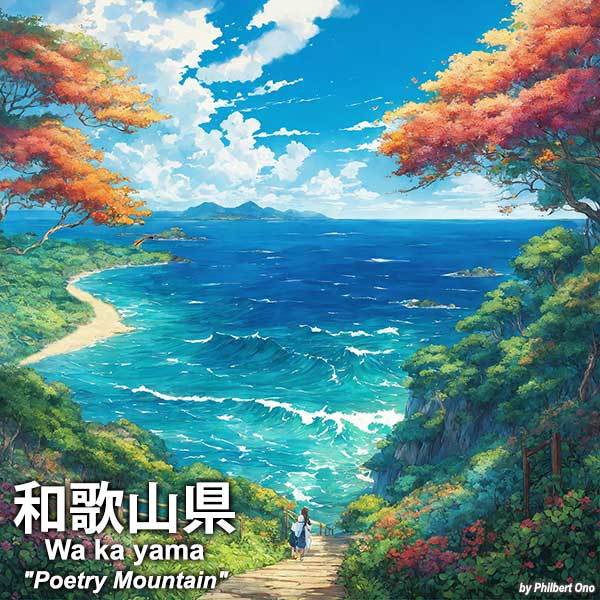WAKAYAMA – Poetry Mountain 和歌山県

Most Japan aficionados would know that waka (和歌) is a famous type of Japanese poetry. So you might think Wakayama is a land of waka poetry. Actually, it’s not as simplistic as that.
“Wakayama” was previously written as 若山 meaning “young mountain.” So originally, in the really old days, the old “Wakayama” name did not have a poetry connection. However, poetry fans would be delighted to know that there is a poetry reason why the waka kanji character (若) later morphed into the waka poetry kanji (和歌).
Most sources, including Wakayama Prefecture’s official website, say that the name “Wakayama” (和歌山) came from the scenic coastal area called “Wakanoura” (和歌浦) in southern Wakayama city.
So we have to investigate the origin of the name “Wakanoura.” (Also pronounced “Wakaura.”)
Turns out that the former kanji characters for Wakanoura were 若の浦 (Young Inlet). According to the Shoku Nihongi (続日本紀) Japanese history from the 8th century, Wakanoura was a tidal flat area called “Wakanohama” or “Yowahama” (弱浜) before the Nara Period (710–794). It may have referred to the tidal flat as young and full of vitality destined to grow.
But in Oct. 724 when Emperor Shomu (聖武天皇) visited Wakanoura, he thought the sunlit landscape was so beautiful that he renamed it “Akanoura” (明光浦) or Illuminated Inlet. He was so impressed by the scenery that he ordered the spirits of Tamatsushima (jewel islands) and Akanoura to be worshipped to protect and preserve the local scenic beauty.
Traveling with Emperor Shomu to Wakanoura was famous poet Yamabe no Akahito (山部赤人) who referred to it as “Wakanoura” (若の浦, Young Inlet) in one of his poems in the Man’yoshu anthology of poems. Maybe he was the one who popularized this name.
At high tide in Wakanoura, the tidal flat disappears and the cranes squawk and fly toward the reeds. (若の浦に 潮満ち来れば 潟を無み 葦辺をさして 鶴(たづ)鳴き渡る)
–Man’yoshu
In the Heian Period (794–1185), the 和歌の浦 kanji characters were used in poetry, replacing the 若 kanji with 和歌.
The Kii-zoku Fudoki (紀伊続風土記), an official chorography written in the early 19th century about Wakayama, says the waka (和歌) may have come from the name of the goddess Waka-Hirume-no-Mikoto (稚日女尊), the younger sister of Sun Goddess Amaterasu, worshipped by Tamatsushima Shrine (玉津島神社) in central Wakanoura.
The shrine also worships the beautiful Princess Sotoorihime (衣通姫), regarded as one of the three gods of waka poetry (Waka Sanjin 和歌三神). Aha! I finally found a waka poetry connection!
Indeed, this shrine, which still exists in the heart of Wakanoura, has been regarded as one of the three major Shinto gods/shrines worshipping waka poetry since olden times. The other two waka shrines are Sumiyoshi Taisha (Sumiyoshi Myojin) in Osaka and Kitano Tenmangu in Kyoto. (In the old days, “waka” referred to most forms of Japanese-style poetry, not just the waka poetry we refer to today.)
When Koya-san (Shingon Buddhist temple complex and headquarters) came to fore and attracted many pilgrims to the area from the 10th century, many of the pilgrims dropped by Wakanoura on the way home. They worshipped at Tamatsushima Shrine to improve their poetry skills.
It was likely during this time when people started using the 和歌の浦 kanji characters for 若の浦. Tamatsushima Shrine has also been visited by famous Japanese poets in past centuries such as Fujiwara no Kintō, Asukai Masanaga (飛鳥井雅永), and Asukai Masachika (飛鳥井 雅親). Today, Wakanoura is both a National Historic Site and Place of Scenic Beauty.

In 1585, when top warlord Toyotomi Hideyoshi unified and conquered Kii Province (present-day Wakayama Prefecture), he assigned the province to his younger brother Toyotomi Hidenaga (豊臣秀長 1540–1591). Hideyoshi ordered Hidenaga to build a provincial castle atop a mountain in a place called Okayama (岡山) or Wakayama (若山).
After the castle was completed in 1586, it was named “Wakayama” (和歌山). The “Waka” coming from “Wakanoura” (和歌浦) and the “yama” perhaps coming from Okayama (岡山).
During the Edo Period, there was a push to use 若山 as the kanji characters, but people used both 若山 and 和歌山. The Meiji government then set it to 和歌山. The prefecture was inevitably named after the place where the local capital was located.
Today, Wakayama Castle is a sprawling compound with impressive castle buildings. Beautiful, especially during cherry blossom season in early April.
Old province name: Kii-no-Kuni (紀伊国)
*The AI-generated image is for illustrative purposes only and may not accurately depict any particular place in the prefecture.
Sources: https://www.pref.wakayama.lg.jp/bcms/prefg/000200/kenmin/web/202112/tokusyu1.html
https://www.nwn.jp/feature/200411_waka/
Origin of other prefectural names (etymologies)
Overview | Aichi | Akita | Aomori | Chiba | Ehime | Fukui | Fukuoka | Fukushima | Gifu | Gunma | Hiroshima | Hokkaido | Hyogo | Ibaraki | Ishikawa | Iwate | Kagawa | Kagoshima | Kanagawa | Kochi | Kumamoto | Kyoto | Mie | Miyagi | Miyazaki | Nagano | Nagasaki | Nara | Niigata | Oita | Okayama | Okinawa | Osaka | Saga | Saitama | Shiga | Shimane | Shizuoka | Tochigi | Tokushima | Tokyo | Tottori | Toyama | Wakayama | Yamagata | Yamaguchi | Yamanashi
